“People here prefer the Taliban to the government”
Taliban insurgents who have infiltrated Kabul are nailing “night letters” to the doors of policemen, soldiers and government workers, warning them to leave their jobs or face punishment.
The militants are being welcomed in the Afghan capital’s poorer areas among inhabitants who are disaffected with corruption, and who supply them with food, cash and weapons.
Safe houses and bomb-making workshops have begun to appear in run-down districts close to the city centre as the militants increase their presence and plot attacks on prominent local targets.
“They know who we are, where we live and what we do,” said Dr Ehsan Anwari, who used to work as an Afghan army medic and now runs a clinic in Company district, where Highway One, the main road from Kandahar to the south, enters the capital. “Whenever we hear shooting we think that the Taliban are taking over the district by force. We are afraid.” [continued…]
Taliban stalls key hydroelectric turbine project in Afghanistan
An enormous hydroelectric turbine dragged at huge cost by British troops through Taliban heartlands last year may never be installed because Nato has been unable to secure a 30-mile stretch of road leading to an isolated dam in northern Helmand.
The daring mission to deliver 220 tonnes of equipment to the Kajaki dam in Afghanistan in September 2008 was hailed as one of the biggest success stories of the British Army’s three-year deployment in Helmand.
Two thousand British troops took part in the five-day convoy through enemy territory, which was launched because the main road leading to the dam was too vulnerable to Taliban attacks.
Senior British officers privately say the enormous diversion of scarce military resources for the operation allowed the Taliban to make major gains in other critical areas of the province, including Nad Ali, which subsequently saw some of the most intense fighting between British forces and insurgents. [continued…]
The blast tore through Sapper Matthew Weston’s body as he searched the mud compound for mines. The rifle he was carrying sliced off his hand, leaving it dangling by a thread of skin. Both his legs were blown off and he could feel the blood gushing from his two remaining stumps as medics leapt on top of him to stem the bleeding with bandages and tourniquets.
The 20-year-old Royal Engineer struggled to sit up, but his fellow soldiers pushed him back to the ground, afraid he might go into shock if he saw what was left of his legs. “It felt like someone smacking me in the head with a baseball bat. My head was thumping and my ears were ringing,” he told me.
 Sapper Weston and his team of mine-clearance experts had been tasked with clearing a dirt track that leads through one of the most dangerous parts of Helmand. Night had fallen when the team from 33 Engineer Regiment began to search for bombs in the compounds that lined the track, known to soldiers as Pharmacy Road.
Sapper Weston and his team of mine-clearance experts had been tasked with clearing a dirt track that leads through one of the most dangerous parts of Helmand. Night had fallen when the team from 33 Engineer Regiment began to search for bombs in the compounds that lined the track, known to soldiers as Pharmacy Road.
“I was the man at the front,” he said. “I didn’t have any night-vision equipment. They just didn’t have enough to go round,” he said matter-of-factly, as he sat on his hospital bed. As he turned to his commander to give the all-clear, the bomb that would leave him crippled for life exploded. Seven others were wounded in the blast, some with deep lacerations to their necks. [continued…]

